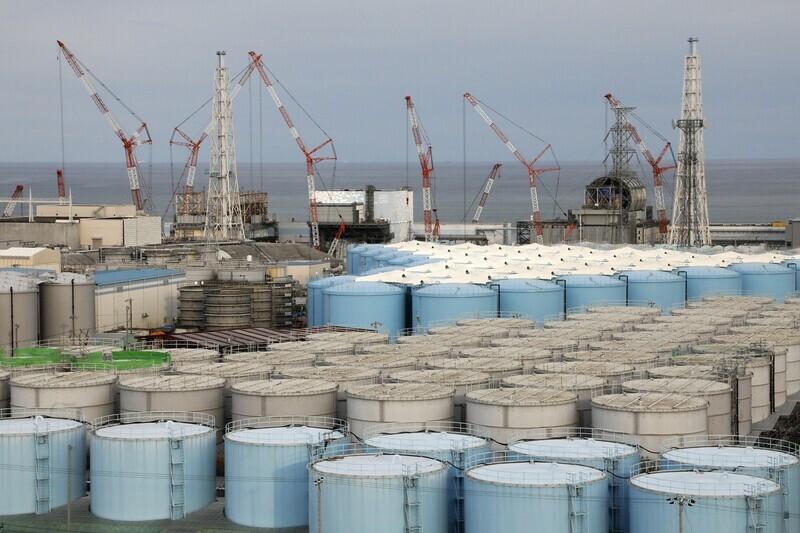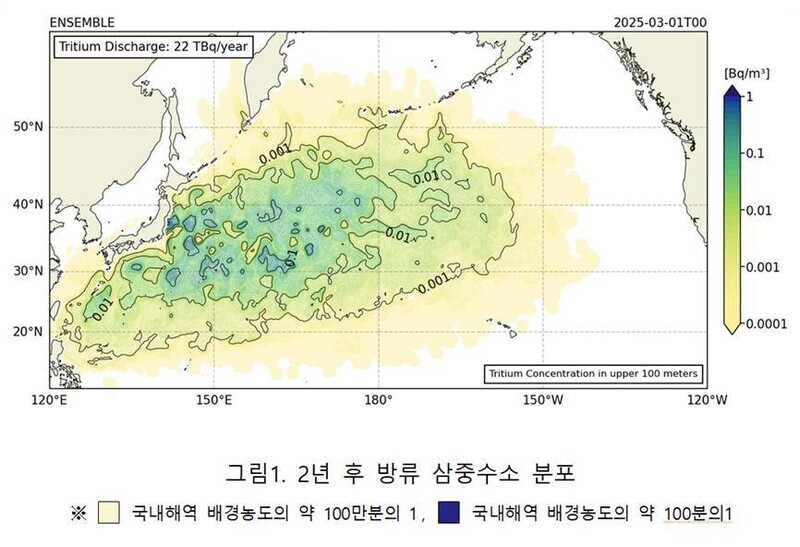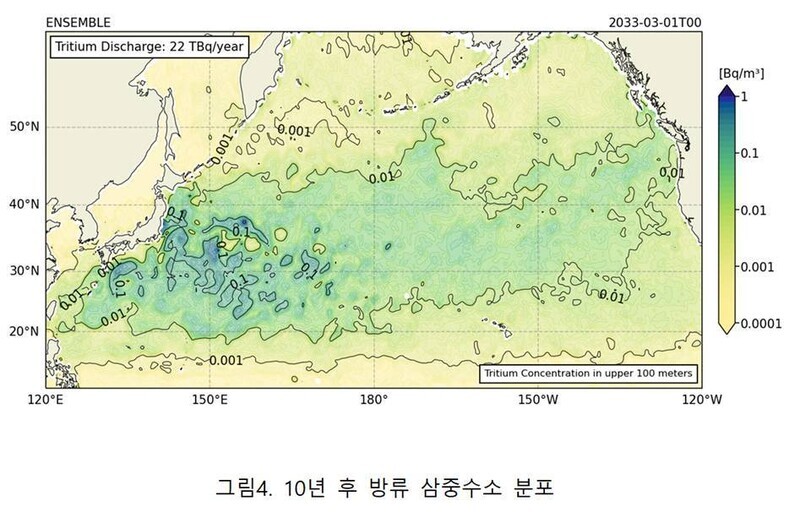hankyoreh
Links to other country sites 다른 나라 사이트 링크
Simulation shows Fukushima wastewater will reach Jeju within 5 years upon dumping

A simulation by South Korean government research institutes has found that if Japan dumps contaminated water from the Fukushima nuclear reactor into the ocean, a radioactive isotope of hydrogen in the contaminated water will begin entering the waters off Jeju Island within four or five years. The same analysis also found that a low concentration of radiation (less than one-millionth of the current background concentration in Korean waters) could temporarily be brought into the area by ocean currents two years after the contaminated water is released.
On Thursday, a joint research team including researchers from the Korea Institute of Ocean Science and Technology (KIOST) and the Korea Atomic Energy Research Institute (KAERI) presented their results of a simulation studying the effects of the diffusion of tritium, a radioactive isotope of hydrogen present in the Fukushima wastewater.
The results of the simulation were presented at an academic conference held by the Korean Society of Hazard Mitigation in Jeju.
The reason for concern is that tritium can decay to helium-3 and affect DNA, which could result in adverse effects on the human body including cell death or deterioration in reproductive function.
This is the first time that the results of a joint simulation conducted by national research institutes on the domestic impact of the release of Fukushima wastewater have been released.
Ever since Japan announced its decision in April 2021 to release the contaminated water, both the previous Moon Jae-in government and the current Yoon Suk-yeol administration have recognized the need to conduct studies, saying that domestic institutes would further advance analysis models and then conduct related studies.
The results of this study were obtained using an analysis model that had been upgraded by late last year.
According to the research results, the tritium present in the wastewater poised to be discharged off the coast of Fukushima, which is located in eastern Japan, would move in an eastward direction due to the strong Kuroshio Current. This would lead the water to the West Coast of the US and then continue to spread throughout the northern parts of the Pacific Ocean.
On the other hand, the inflow of this water to the Korean Peninsula would be slower given the weak ocean currents.

The analysis predicts that around four to five years will pass after the release of the wastewater before tritium begins flowing in Jeju waters.
Even though the Korean Peninsula is situated geographically close to Japan, it is expected to be affected by the wastewater at a later time than, for example, the Pacific Coast of the US, because the seawater flows eastward from Japan due to the influence of ocean currents.
Since the Korean Peninsula is located to the west of Japan, the water will first spread to the Pacific Ocean and then begin making its way to Korean waters.
The research team predicted that the concentration of tritium flowing into Jeju waters would reach around 0.001 becquerels (Bq) per cubic meter of water 10 years after the release of the Fukushima wastewater. A becquerel is a unit of radioactivity.
This concentration is one-100,000th of the average tritium concentration (background concentration) of the 172 Bq/m3 in domestic seawater analyzed by the Korea Institute of Nuclear Safety.
“This concentration is a concentration [level] that is difficult to detect with an analysis device,” the research team explained.
However, the study also found that the timing of wastewater inflow into Korean waters could change every year depending on specific characteristics of the ocean currents.
In fact, the joint simulation showed a temporary inflow of wastewater into Korean waters due to the influence of sea currents just two years after its release, albeit at a low concentration of 0.0001 Bq/m3.
“Ocean currents do not flow steadily, but change from season to season,” says Kim Kyeong-ok, a senior researcher at KIOST who helped carry out this simulation.
“The reason for the temporary influx of tritium two years after the [wastewater] release is because the ocean current is strong at this time,” Kim explained.
The simulation results from Korean researchers are not very different from what previous studies conducted in China concluded.
In 2021, a simulation conducted by an international research team led by researchers from the First Institute of Oceanography of China’s Ministry of Natural Resources found that tritium reached South Korean waters at a concentration of about 0.001 Bq/m3 five years after the initial release of the wastewater.
Last year, another simulation conducted by a research team at Tsinghua University in China predicted that tritium would reach Korean waters after 10 years at a concentration level of one-hundredth the levels present in the Pacific Ocean east of Japan.
“Tritium released off the coast of Fukushima was found to spread throughout the entire northern part of the Pacific Ocean 10 years later. These are similar results to China's simulation study on the spread of the wastewater,” the KOIST and KAERI joint research team said.
This simulation was based on the assumption that Japan would release 22 trillion Bq of tritium annually for 10 years from next month into the ocean located about 1 kilometer from the Fukushima nuclear power plant.
The figure of 22 trillion Bq is the maximum amount Japan plans to release annually.
However, this simulation was only focused on the diffusion of tritium, meaning that the spread of other radioactive nuclides throughout the food chain or the effects of their accumulation in water was not taken into consideration.
Therefore, this analysis does not represent the full environmental impact that the discharge of the wastewater would actually have. In reality, besides tritium, the wastewater Japan plans to release into the ocean contains many more radioactive materials as well.

While Japan’s Tokyo Electric Power Company (TEPCO) announced plans to begin the release of the wastewater this spring, this schedule could be delayed if reviews related to wastewater monitoring plans currently underway by the Japan Atomic Energy Commission and the International Atomic Energy Agency are prolonged.
Regarding the results of this simulation, both environmental groups and opposition parties in Korea remain unconvinced, arguing that it is too hasty to conclude that the impact on Korea from the Fukushima wastewater will be negligible based solely on this simulation.
The reasoning behind this stance is the argument that the Japanese data used to conduct this study is unreliable and that the concentration levels of other radioactive materials were not considered.
“Many experts, including the US National Association of Marine Laboratories, which is affiliated with more than 100 marine research institutes, don’t trust the Japanese government’s data and plans based on the lack of important data regarding the amount of radionuclides in each tank where contaminated water is stored and the lack of efficiency of the ALPS (Advanced Liquid Processing System),” the Korea Federation for Environmental Movements said in a statement.
“The safety of discharging the wastewater into the ocean should not be evaluated solely by [measuring] the concentration levels of radioactive materials in seawater," KFEM added.
In addition, the Democratic Party’s response team aimed at stopping the discharge of the Fukushima wastewater also spoke out after the simulation results were published, saying, “The priority should be verifying Japan’s false data.”
“It is difficult to expect reliability because these results are based on Japan’s false data and claims,” the team said in a statement.
“What we need to do now is to request verifiable and transparent data regarding the Fukushima wastewater from the Japanese government and to prepare for international legal responses, such as provisional measures, to stop the release of the Fukushima wastewater,” the team argued.
By Kim Jeong-su, senior staff writer
Please direct questions or comments to [english@hani.co.kr]

Editorial・opinion
![[Column] Park Geun-hye déjà vu in Yoon Suk-yeol [Column] Park Geun-hye déjà vu in Yoon Suk-yeol](https://flexible.img.hani.co.kr/flexible/normal/500/300/imgdb/original/2024/0424/651713945113788.jpg) [Column] Park Geun-hye déjà vu in Yoon Suk-yeol
[Column] Park Geun-hye déjà vu in Yoon Suk-yeol![[Editorial] New weight of N. Korea’s nuclear threats makes dialogue all the more urgent [Editorial] New weight of N. Korea’s nuclear threats makes dialogue all the more urgent](https://flexible.img.hani.co.kr/flexible/normal/500/300/imgdb/original/2024/0424/7317139454662664.jpg) [Editorial] New weight of N. Korea’s nuclear threats makes dialogue all the more urgent
[Editorial] New weight of N. Korea’s nuclear threats makes dialogue all the more urgent- [Guest essay] The real reason Korea’s new right wants to dub Rhee a founding father
- [Column] ‘Choson’: Is it time we start referring to N. Korea in its own terms?
- [Editorial] Japan’s rewriting of history with Korea has gone too far
- [Column] The president’s questionable capacity for dialogue
- [Column] Are chaebol firms just pizza pies for families to divvy up as they please?
- [Column] Has Korea, too, crossed the Rubicon on China?
- [Correspondent’s column] In Japan’s alliance with US, echoes of its past alliances with UK
- [Editorial] Does Yoon think the Korean public is wrong?
Most viewed articles
- 1‘We must say no’: Seoul defense chief on Korean, USFK involvement in hypothetical Taiwan crisis
- 2N. Korean delegation’s trip to Iran shows how Pyongyang is leveraging ties with Moscow
- 3Amnesty notes ‘erosion’ of freedom of expression in Korea in annual human rights report
- 4[Column] Park Geun-hye déjà vu in Yoon Suk-yeol
- 5‘Weddingflation’ breaks the bank for Korean couples-to-be
- 6[Reportage] On US campuses, student risk arrest as they call for divestment from Israel
- 7[Editorial] New weight of N. Korea’s nuclear threats makes dialogue all the more urgent
- 8Why Korea shouldn’t welcome Japan’s newly beefed up defense cooperation with US
- 9[Guest essay] The real reason Korea’s new right wants to dub Rhee a founding father
- 10Will NewJeans end up collateral damage in internal feud at K-pop juggernaut Hybe?